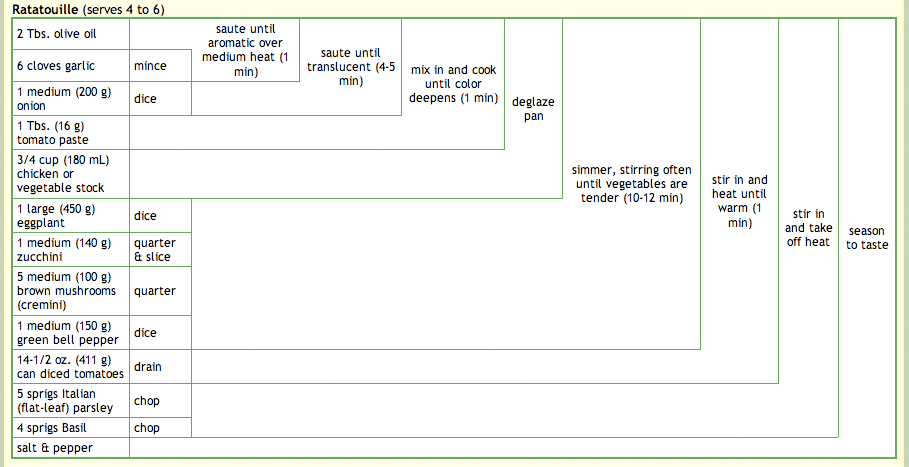Yesterday a reader left us an intriguing comment on a post I wrote months ago, about a conflict at the New York Junior League. [The post was one of my first efforts, and is so poorly formatted that I’m embarrassed to have you go look at it, but…]
Liz wrote about how, at the NYJL, the most egregious element of how the President handled her concerns with the NYJL Board was that she took her campaign to outsiders.
(The President) violated one of the most sacred principles of all- she violated League trust by turning to outsiders who don’t understand the organization. That’s the true source of the problem.
A principle authentic to the NYJL has issues presented and handled internally, in a particular way. Liz reminded me of the old Org Development adage: “Meet the organization where it is.” Usually I’ve taken this to mean, ‘start at the place in their understanding of change, not at yours’. But when I saw this chart I had another idea:

This chart is from a website Cooking for Engineers (thanks to Sara at 37signals.com). The chart is small, so click here to get a bigger view.)
It’s a recipe for ratatouille— but not in the traditional recipe format, such as you would seen at a website for cooks, like Take Back the Kitchen. Nope– it’s in a format specifically designed for and attractive to the organization’s members/readers: Engineers.
An Authentic Way to Communicate
This chart is a wonderful example of ‘meeting the organization where it is’ by communicating in a way that is authentic to the organization.
How is this chart an authentic way to communicate with engineers? It’s formatted in a way that visually emphasizes the steps and their order, shows how the finished product ‘accumulates’ from each step, and minimizes the number of words used to communicate what’s to be done.
This chart lays out information in a format that is easily recognized as instructions in a flow chart. And, it probably evokes a snort or chuckle from anyone who is an engineer or who works closely with engineers, because you can see in the chart ‘who’ the people are that the chart is communicating to.
The style and substance/ form and content of the chart tells you about the organization that made it, and the organization that reads it.
[ Do you know any engineers? When I worked at the Ivory Soap Plant as an organizational development specialist, my business card read”Process Engineer”. Was I an engineer? Not really, but describing my role as analogous to a type of engineer helped the Chemical, Mechanical, and Heat Transfer Engineers (aka most of the other managers) understand what I was there to do! ]
Moreover, any engineer looking at that chart can
see herself in that chart.
How is This Relevant to Authenticity?
Each organization communicates with itself and with its members. Some organizations communicate in a language that is as generic as possible, stripped of uniqueness, “all business”, no personality.
I wonder:
- Do authentic organizations communicate in a different way?
- Is it more likely that an authentic organization will be ‘creative’, take a risk, or in some other way get to the point where it uses its own unique language, in its own internally-recognizable forms?
- What would it take to get your organization to communicate something to you, in a way that is so specific to itself, that members see themselves in the communication?
What do you think? Comment, below…..
 I am an organizational consultant, change advocate, and organizational identity/reputation scholar with a PhD in leadership & organizations. I research, write about, and consult with organizations on the relationships between organizational identity, actions, and purpose. I teach Technology Management, part-time, at Stevens Institute of Technology.
My current research focuses on how social technologies in the workplace can drive organizational change, generate meaning, and catalyze purpose. See the
I am an organizational consultant, change advocate, and organizational identity/reputation scholar with a PhD in leadership & organizations. I research, write about, and consult with organizations on the relationships between organizational identity, actions, and purpose. I teach Technology Management, part-time, at Stevens Institute of Technology.
My current research focuses on how social technologies in the workplace can drive organizational change, generate meaning, and catalyze purpose. See the 
{ 2 comments }
Fascinating post, CV.
A brief request that I suspect that other newbies share. Can you occasionally define terms such as CSA and your various standard disclaimers?
Sure! The CSA is Community Supported Agriculture (group)– I shouldn’t assume that you’d remember or have seen oldeer posts– so I’ll try to define my terms every time. The standard disclaimers i mention and offer a hot link to the page where I spell them out…next time I need to disclaim I’ll send you all there clearly. Thanks for the heads up.
Comments on this entry are closed.